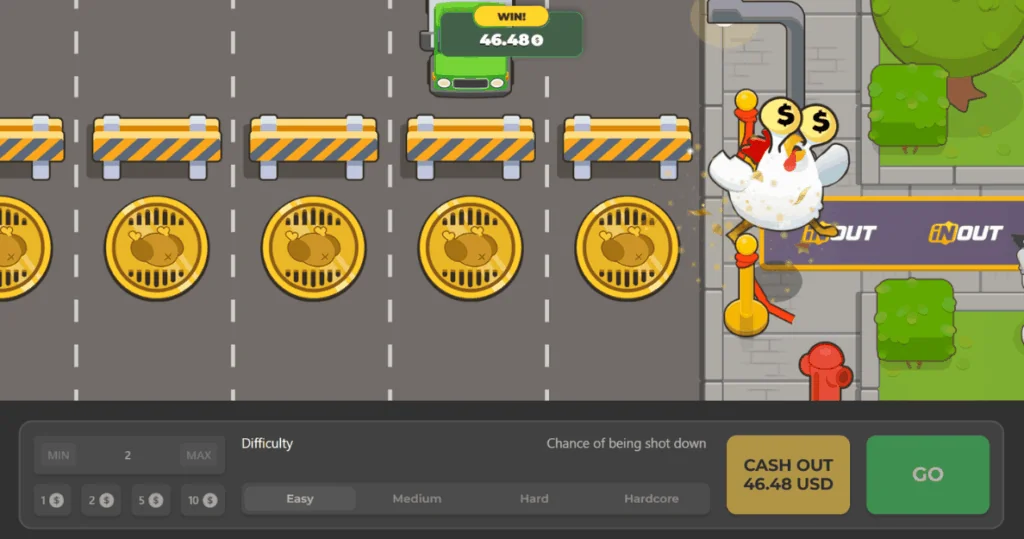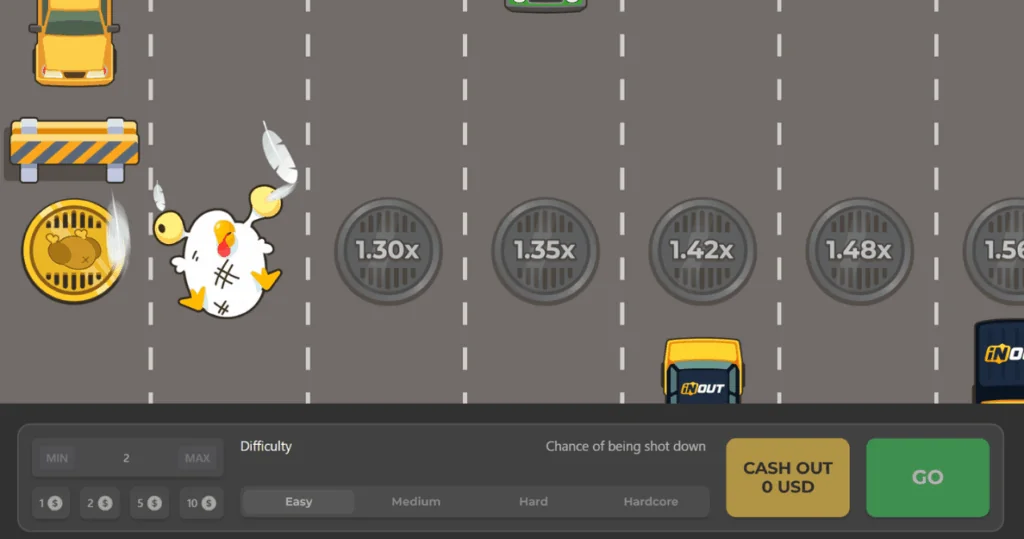Chicken Road 2 — Bigger Multipliers, Smarter Risk, Same White-Knuckle Thrill
Chicken Road 2 takes the original step-by-step crash classic and upgrades everything that matters: cleaner visuals, sharper feedback, optional power-ups, and new ways to pace risk without losing that “one more step” adrenaline. If Chicken Road was a dare, Chicken Road 2 Game is a full-blown challenge — faster loops, deeper decisions, and more control over how (and when) you cash out.
On this page, you’ll get a practical, copy-and-paste guide to mastering Chicken Road 2: how each mode works, what’s new compared to the original, sensible bankroll frameworks, and a full FAQ. You’ll also find quick-start checklists, smart strategies, and responsible-play guardrails so every session stays fun, focused, and on your terms.
What Is Chicken Road 2?
Chicken Road 2 is a crash-style decision game built around a single loop: step forward for a bigger payout or cash out now and bank what you’ve earned. The twist is how 2.0 layers optional tools on that loop — things like pre-run boosts, “second-chance” mechanics, and clearer risk readouts — giving disciplined players more ways to structure sessions without dulling the tension.
- Same core dare: Safe tiles raise your multiplier; electrified tiles end the run.
- More visibility: Cleaner UI, distinct audio cues, and progress meters that make each decision feel deliberate.
- Optional depth: Power-ups and mode variations you can toggle on or ignore. Your call.
If you love the original but want a version that rewards planning and pace control, 2.0 is the sweet spot.
What’s New vs. the Original

Chicken Road 2 keeps the heart of the game intact and upgrades the decision space. Here’s a high-level comparison you can scan at a glance:
| Feature | Chicken Road (Original) | Chicken Road 2 | Why It Matters |
|---|---|---|---|
| Visual Feedback | Basic glow/buzz cues | Sharper animations, clearer step states | Reduces hesitation; decisions feel cleaner |
| Mode Variety | Easy / Medium / Hard / Hardcore | Classic modes + optional variants (e.g., Surge, Marathon) | Match risk to time and temperament |
| Power-Ups (Optional) | None or minimal | Single-use tools like Shield, Scout, or Boost | Adds tactical depth without slowing the loop |
| Session Tools | Manual cash-out only | Auto-cash targets, step caps, pace timers | Helps enforce discipline and avoid tilt |
| Progression | Standalone runs | Optional streak trackers & milestone rewards | Encourages planned sequences over random clicks |
Game Flow — From Stake to Cash-Out
- Set your stake. Pick a bet per run that supports your entire session plan.
- Choose a mode. Classic or a Chicken Road 2 variant. Harder modes climb faster and punish mistakes.
- (Optional) Add a power-up. Shield, Scout, or Boost — one per run if you choose to use them.
- Start the run. Tap onto the first tile; safe steps raise your multiplier.
- Decide every step. Cash out now or risk another hop. Tools like auto-cash can execute your plan automatically.
That’s the loop: simple on paper, tense in practice. 2.0’s extras are there to support better decisions, not to play for you.
Modes & Variants — Choose Your Road
Names vary by operator, but this mindset map captures how each difficulty feels. Use it to pick the right road for your nerves and schedule.
| Mode | Road Length | Safe Tile Density | Multiplier Tempo | Playstyle Fit |
|---|---|---|---|---|
| Easy | Longest | Highest | Smooth climb | Warm-ups, steady sessions, learning power-ups |
| Medium | Mid | Balanced | Quicker climb | Default choice for most runs |
| Hard | Short | Low | Fast climb | Short, high-impact bursts with strict exits |
| Hardcore | Shortest | Very low | Explosive | Experienced players only; pre-set auto-cash |
| Surge (2.0) | Short | Low | Starts fast, accelerates | Great for promo boosts and highlight attempts |
| Marathon (2.0) | Long | Moderate | Gentle ramp | Longer, calmer sequences with frequent cash-outs |
Optional Power-Ups (Use Wisely)
Power-ups add a tactical layer. They don’t “win the game”; they help you execute a plan. If your platform offers them, here’s how to think about each:
- Shield: Negates a single failure once per run. Best when you’re two steps from your target and want insulation from a single mistake.
- Scout: Reveals the state of one upcoming tile (or a small cluster) before you move. Use early to calibrate risk, not late to chase.
- Boost: Slightly increases multiplier growth for a few steps. Pair with strict auto-cash; greed and Boost are a messy combo.
Guideline: One power-up per run, paired with a specific rule (e.g., “Boost on Medium → cash at 3 safe steps”). Tools without rules become tilt fuel.
Stake Bands & Session Planning
Chicken Road 2’s faster pace means your stake needs to buy enough attempts to let judgment beat impulse. Choose the band that matches your time and temperament:
| Stake Band | Session Feel | Recommended Plan |
|---|---|---|
| Micro | Long, low-stress | Marathon/Easy; early cash-outs; power-ups optional |
| Standard | Balanced | Medium base; occasional Surge attempts with Shield |
| High | Short, intense | Hard/Hardcore with auto-cash; Boost only with strict caps |
Rule of thumb: Budget for 20–40 runs at your default stake. If one mistake wrecks the entire plan, the stake is too high.
Session Blueprint — First 15 Minutes in Chicken Road 2
- Warm-up (3 minutes): Easy or Marathon, no power-ups, cash at 2 safe steps.
- Main phase (8 minutes): Medium, consider Shield; target 2–3 safe steps then bank.
- Optional spike (2–4 minutes): Surge with Boost or Hard with auto-cash. One or two attempts max.
End with one calm Easy run and an early cash-out. Closing on discipline prevents the “one last ride” spiral.
Practical Strategy — Decisions That Compound

1) Pre-Commit Your Exits
- Set a profit lock per run (e.g., “cash at 3 safe steps” or “cash at X multiplier”).
- Set a loss cap per session (e.g., three full-stake busts or a %-based stop).
- Use auto-cash to remove hesitation in Hard/Surge/Hardcore attempts.
2) Use Power-Ups Like Seatbelts
- Shield when you’re closing in on target, not at the start.
- Scout in the first or second step to set tone; don’t chase late reveals.
- Boost only with a pre-declared exit (e.g., “Boost → two steps → cash”).
3) Rotate Modes to Reset Your Brain
Cycle Medium → Easy → Medium instead of repeating Hard ten times. Rhythm resets beat tilt.
4) Cadence Counts
Adopt a “one-two-decide” tempo: breathe, check multiplier, decide. Snap clicks are how good plans die.
Common Mistakes in Chicken Road Game 2 (and Fixes)
- Power-up spamming: Tools without rules lead to sloppy exits. Fix: one tool + one rule per run.
- Ignoring auto-cash: If you’re in Hard/Hardcore and still manual-cashing, you’re tempting fate. Fix: set a multiplier target and let the system execute.
- Chasing after a zap: Tilt buying is real. Fix: mandatory one-minute pause or a single Micro run before resuming standard stake.
- Playing tired: Chicken Road 2 Game is faster; foggy brains push one step too far. Fix: shorter sessions, scheduled breaks.
Audio & Visual Readability — Use the Signals, Ignore the Myths
Chicken Road 2 leans on crisp sound and animation to signal state changes. Treat these as pacing tools, not predictions:
- Sound build-ups help you slow down before committing.
- Tile highlights emphasize the decision moment — they don’t reveal outcomes.
- Meter nudges keep your eyes on the current multiplier so you don’t over-step your plan.
Bonuses & Events — Fuel, Not Permission
Promos, seasonal events, or streak rewards can extend your plan if you match them to the right modes:
- Match risk to bonus size: Bigger promos pair better with Surge/Hard where growth is faster.
- Milestone rewards: If streak milestones exist, aim for modest targets (e.g., five conservative cash-outs) rather than one huge run.
- Never exceed the envelope: Bonuses don’t erase loss caps. Respect the line.
Mobile Play — Built for One-Thumb Nerve Tests
Chicken Road 2 streamlined interface shines on phones. For best results:
- Use portrait for single-hand control; landscape if you want larger tiles.
- Enable haptics to anchor timing; tactile micro-feedback curbs snap clicks.
- Keep runs short and intentional — this is a sprint game.
Who Will Love Chicken Road 2
| Clicks With | Probably Not For |
|---|---|
| Players who want control and deliberate decision points | Players who want passive spinning or long auto-play chains |
| Short, focused sessions with visible progress | Marathon play without clear goals |
| Strategy-minded risk takers who value discipline | Impulse players who hate rules and exit plans |
Responsible Play — Guardrails That Keep the Game Fun
- Treat it like entertainment: Decide today’s budget before the first step.
- Use the tools: Time reminders, deposit caps, and cool-downs are your friends.
- Know the signals: Chasing, hiding play, or feeling pressured? Step away and reset.
Wins feel better when you sleep well. Keep the game a game.
Quick Start Checklist
- Pick stake → budget for 20–40 runs.
- Choose Medium (or Marathon for calm starts).
- Set auto-cash or a strict manual exit rule.
- Optional: one power-up with one rule.
- Finish the session with a small, calm win — not a desperate chase.
Glossary
- Auto-Cash – An automatic cash-out trigger at a set multiplier or step count.
- Surge Mode – A short variant with faster multiplier growth and higher risk.
- Marathon Mode – A longer variant designed for steady, early cash-outs.
- Shield / Scout / Boost – Optional power-ups that add insulation, information, or faster growth.